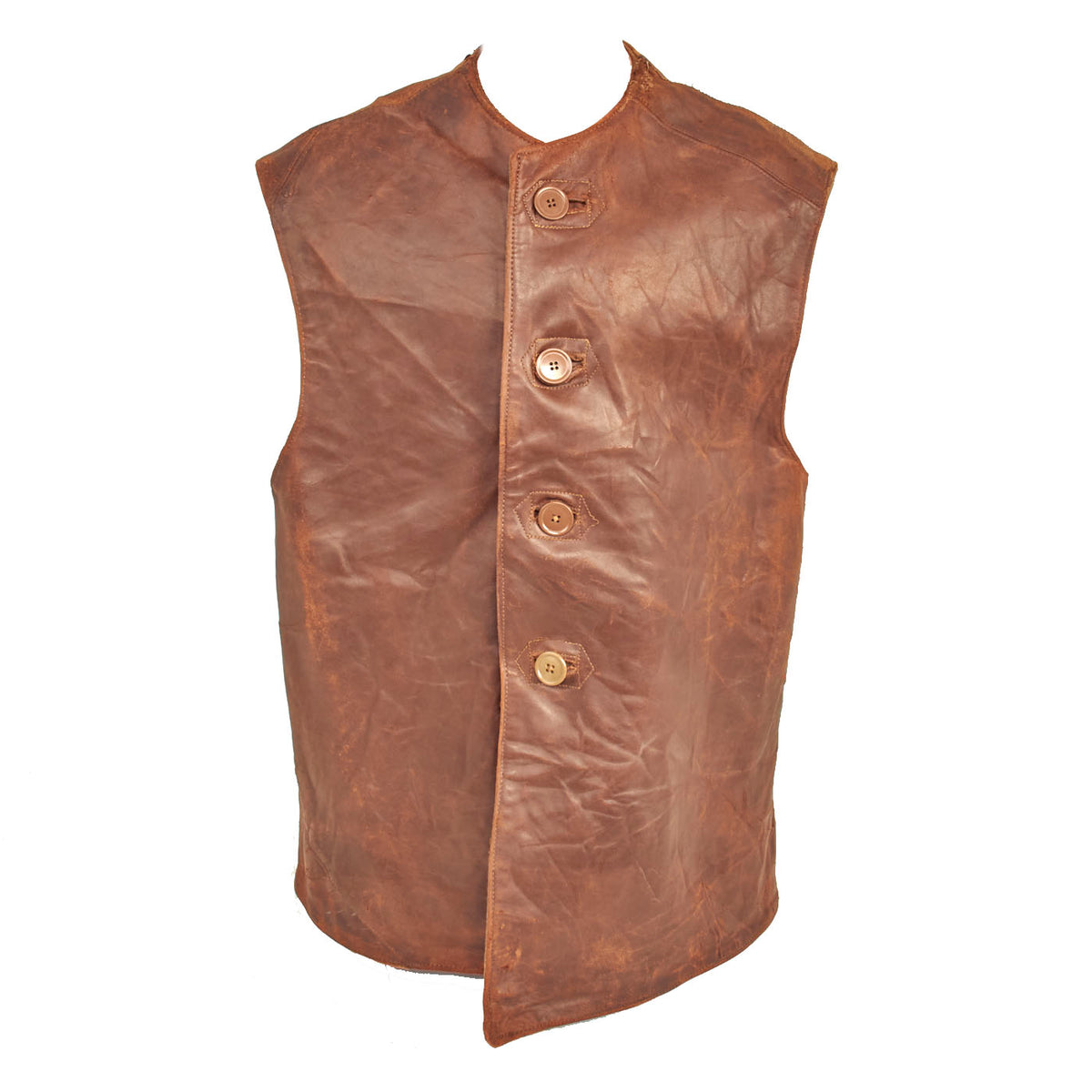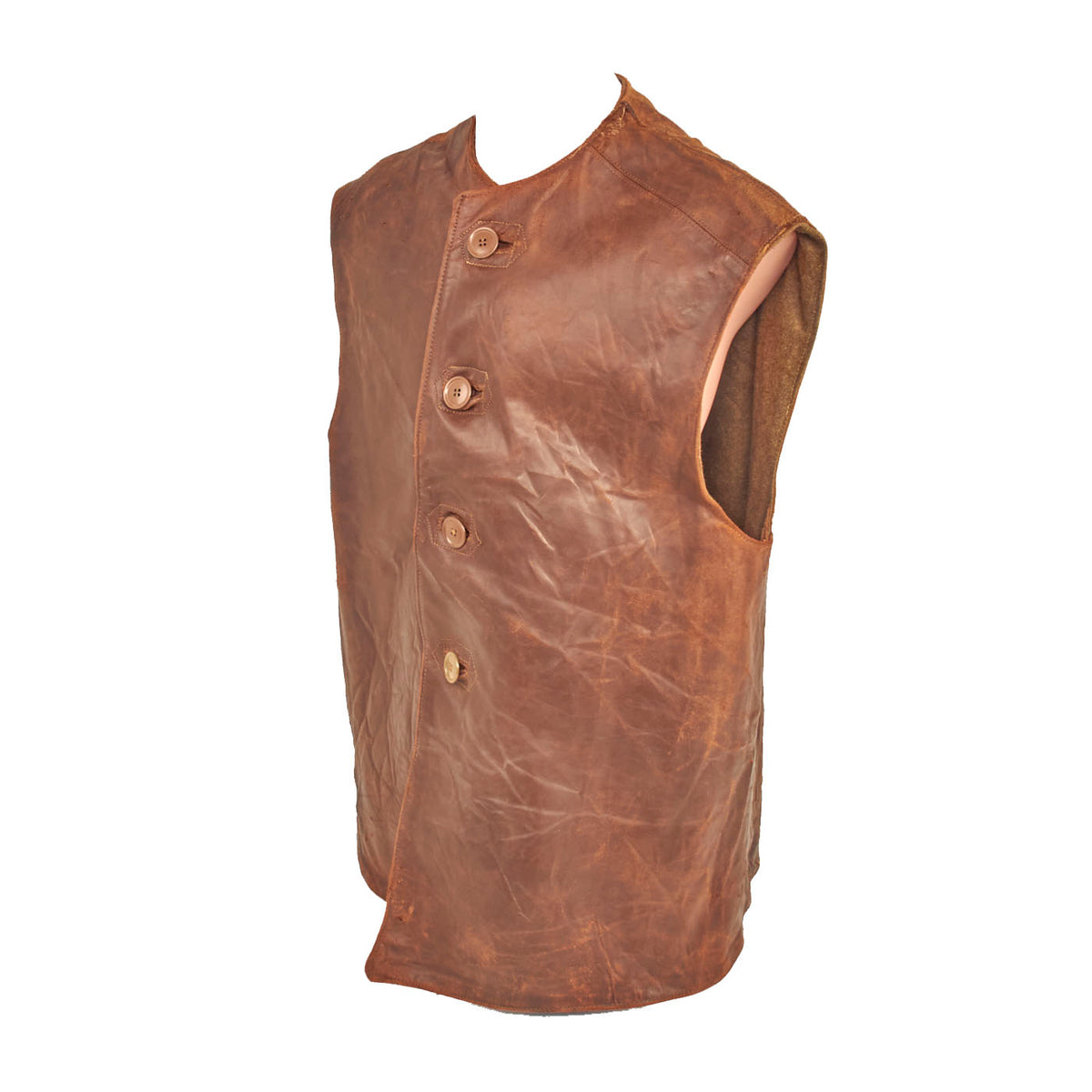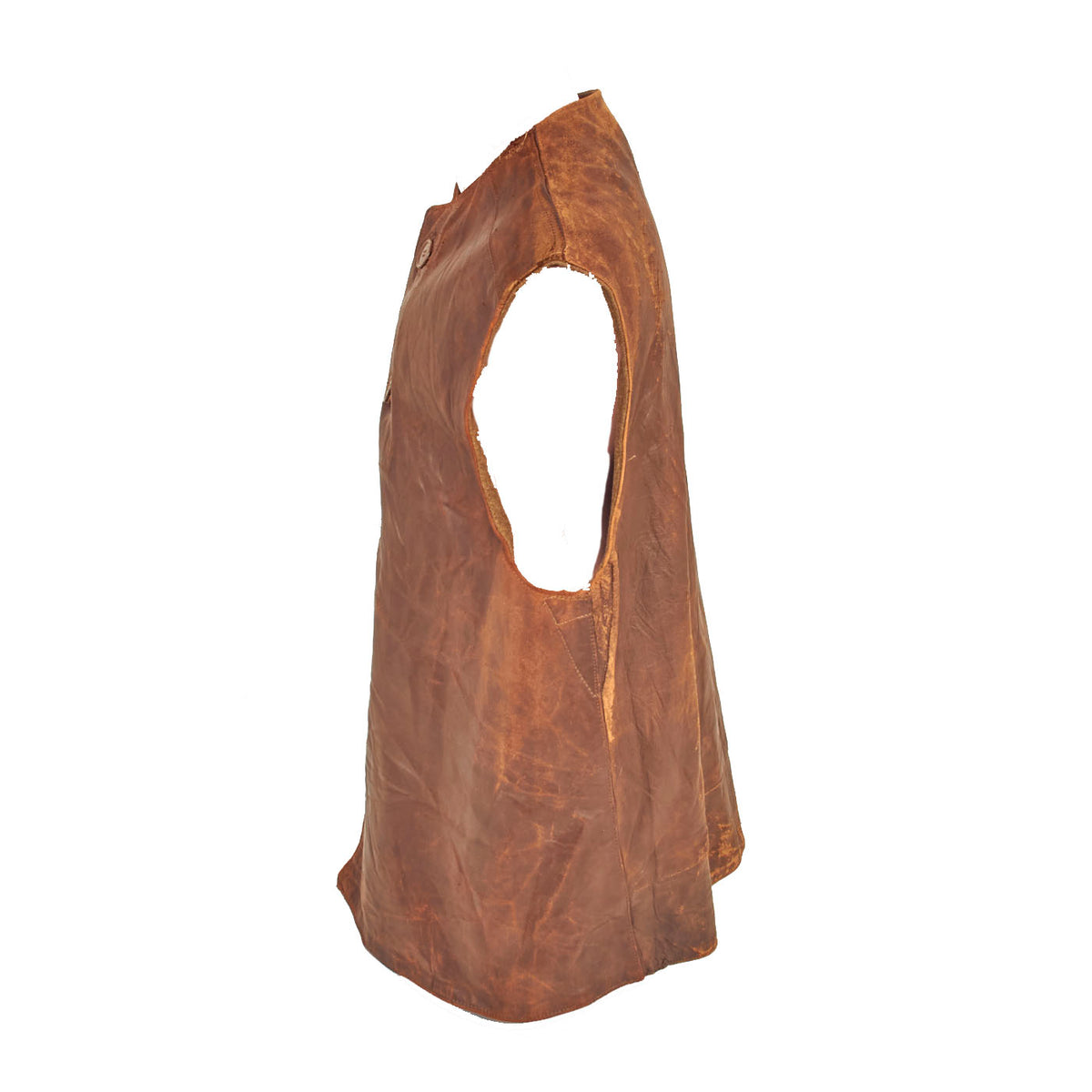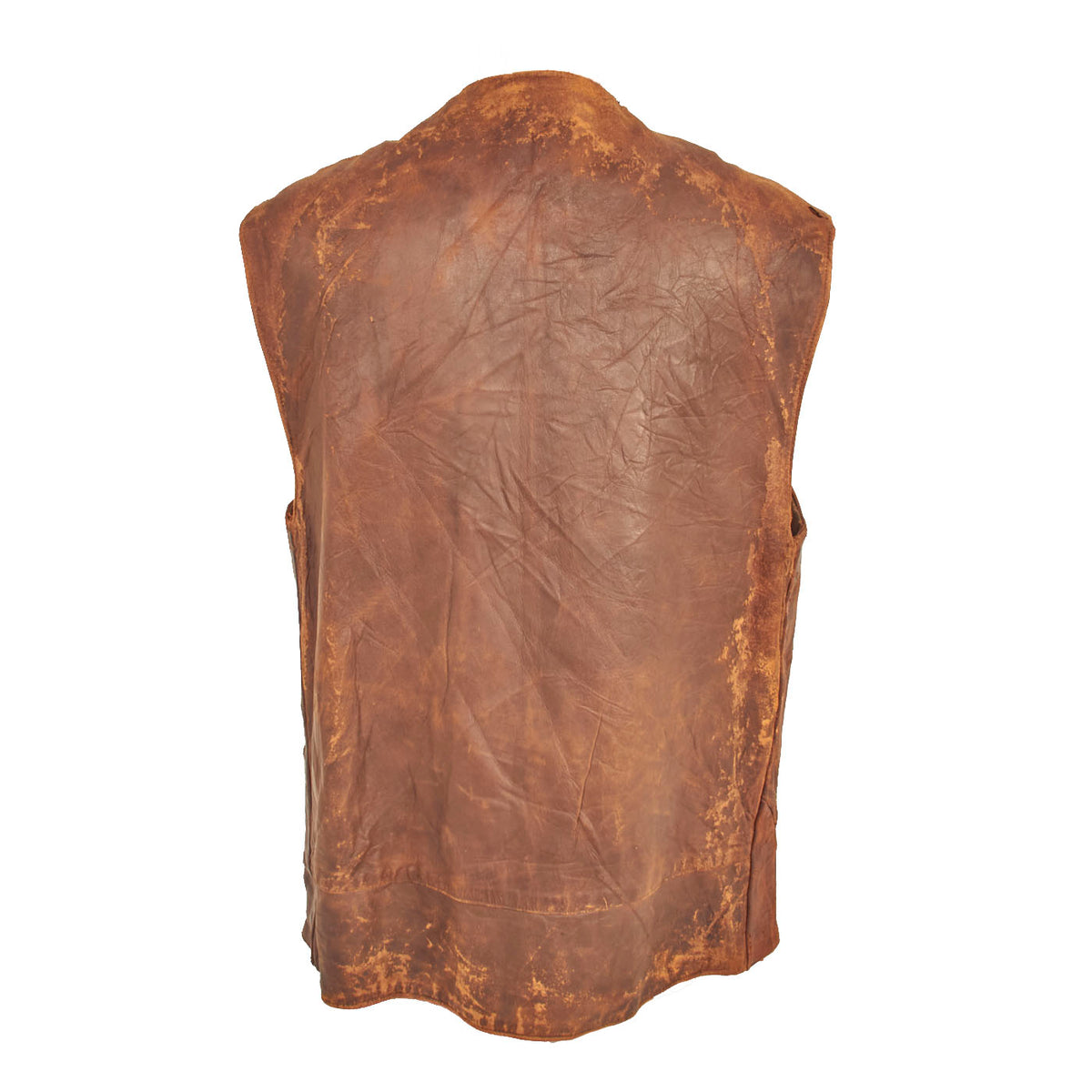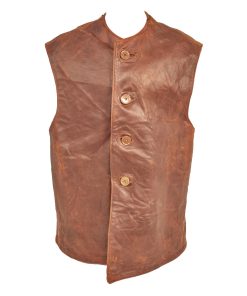Original British WWII Leather Machine Gunner Jerkin Vest – Dated 1945 Original Items
$ 325,00 $ 97,50
Original Item: Only One Available. A jerkin is a man’s short close-fitting jacket, made usually of light-coloured leather, and often without sleeves, worn over the doublet in the sixteenth and seventeenth centuries. The term is also applied to a similar sleeveless garment worn by the British Army in the 20th century.
During the First World War, the British army issued brown leather jerkins to the troops as a measure to protect against the cold but to allow freedom of movement. These garments generally had four buttons and were lined with khaki wool. They were practical, hardwearing and extremely appreciated by officers and other ranks alike. By the time of the Second World War, the leather jerkins were still in issue to all the Commonwealth forces and were universally popular. Jerkins made in Canada were dark brown with black wool linings and differed in general appearance from the British jerkins.
The jerkins from the Second World War had bakelite buttons instead of the brass or brown leather of the originals, and were each unique in that they were finished around the bottom edges with offcuts in a bid to eliminate waste. (It has been suggested that many of the World War II jerkins were made up from leather left over from the Irvin flying jackets also in production in the UK – however, the flying jackets were made of sheepskin so this may not be the case). Jerkins remained warm and comfortable garments to wear whilst fighting, working or driving, and came to characterize the British forces as a preferred alternative to the heavy greatcoats that other armies persisted with. Horsehide Leather Jerkins of the Great War/Second World War pattern continued to be produced into the late 1950s before being replaced with a version made of artificial leather.
A practical garment known as the Battle Jerkin was developed in 1942 by Colonel Rivers-MacPherson of the British Army; a modification of the English hunting vest, it was developed into a garment made of heavy-duty dark brown, water-repellent canvas with multiple pockets and attachment points for field equipment such as the standard issue entrenching tool that formed part of the 1937 Pattern Web Equipment. While originally intended to replace the conventional web gear then in use, the original Battle Jerkin was soon found to be too cumbersome and lacking the flexibility of 1937 Pattern webbing to add and remove items as demanded by operational realities. Furthermore, the garment was found to cause soldiers to overheat during strenuous activities and only very limited numbers were issued to assault troops for the Normandy landings.
A lighter, skeletonised version consisting only of a Y-shaped back piece and two large ammunition pouches on the chest as well as webbing straps for attaching other kit was used widely by commando personnel in 1944–45 to carry ammunition.
This leather jerkin is dated 1945 and shows signs of moderate wear. The inside wool lining is completely intact and appears virtually undamaged with all leather tabs still present behind the button. The inside right still has a legible tag:
JERKINS LEATHER
NO 2
SIZE NO 2
HEIGHT
5ft. 7 ins. To 5ft. 10ins.
BREAST over JACKET
37ins. To 43ins.
H&S LTD. A.
FEB (broad arrow) 1945
No collection is complete without a genuine WWII issue British Leather Jerkin! Comes more than ready to be added to your WWII British displays!
Measurements:
Collar to shoulder: 11”
Shoulder to sleeve: N/A”
Shoulder to shoulder: 24”
Chest width: 24”
Waist width: 27”
Hip width: 27”
Front length: 34″
Fast Shipping with Professional Packaging
Thanks to our longstanding association with UPS FedEx DHL, and other major international carriers, we are able to provide a range of shipping options. Our warehouse staff is expertly trained and will wrap your products according to our exact and precise specifications. Prior to shipping, your goods will be thoroughly examined and securely secured. We ship to thousands clients each day across multiple countries. This shows how we're dedicated to be the largest retailer on the internet. Warehouses and distribution centres can be located throughout Europe as well as the USA.
Note: Orders with more than one item will be assigned a processing date depending on the item.
Before shipping before shipping, we'll conduct a thorough inspection of the items you have ordered. Today, the majority of orders will be delivered within 48 hours. The delivery time will be between 3-7 days.
Returns
The stock is dynamic and we cannot completely manage it because multiple stakeholders are involved, including our factory and warehouse. So the actual stock may alter at any time. It's possible that you may not receive your order once the order has been made.
Our policy is valid for a period of 30 days. If you don't receive the product within 30 days, we are not able to issue a refund or an exchange.
You can only return an item if it is unused and in the same state as the day you received it. You must have the item in its original packaging.
Related products
Uncategorized
Uncategorized
Uncategorized
Uncategorized
Uncategorized
Uncategorized
Uncategorized
Uncategorized
Uncategorized
Armoured Fighting Vehicles of the World: AFVs of World War One (Hardcover Book) New Made Items
Uncategorized
Angolan Rebel 1970s era 60mm Inert Display Mortar from Angolan Civil War Original Items
Uncategorized
Uncategorized
Uncategorized
Uncategorized
Uncategorized
Band of Brothers ORIGINAL GERMAN WWII Le. F.H. 18 10.5cm ARTILLERY PIECE Original Items
Uncategorized
Uncategorized
Armored Burgonet Helmet & Polearm from Scottish Castle Leith Hall Circa 1700 Original Items
Uncategorized
Australian WWII Owen MK1 Machine Carbine SMG Custom Fabricated Replica with Sling Original Items
Uncategorized
Uncategorized
